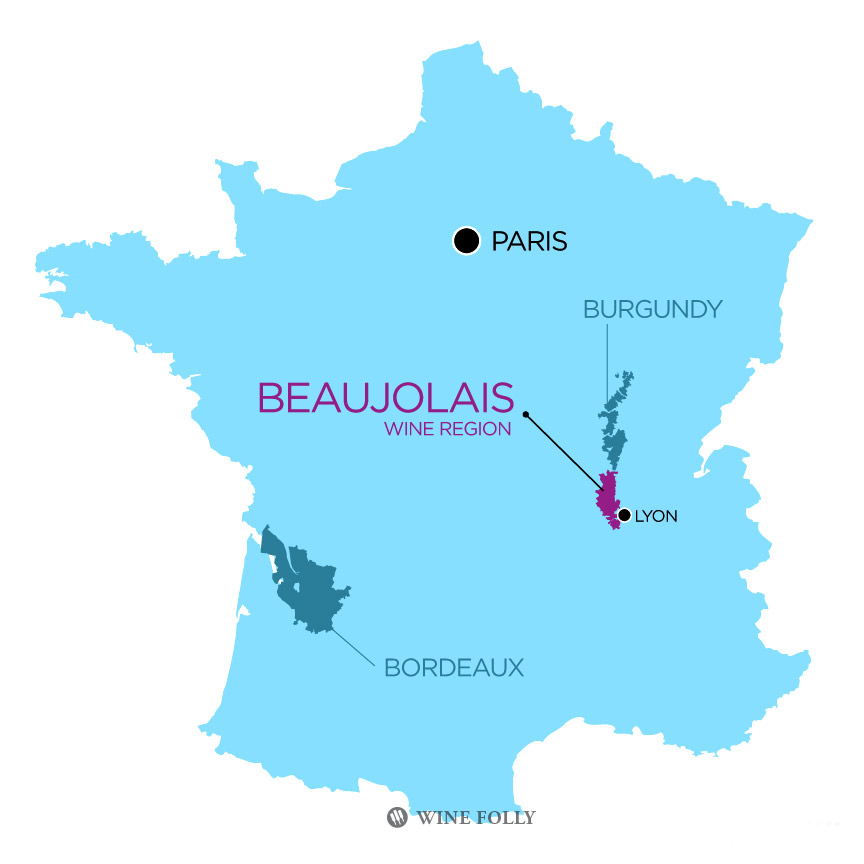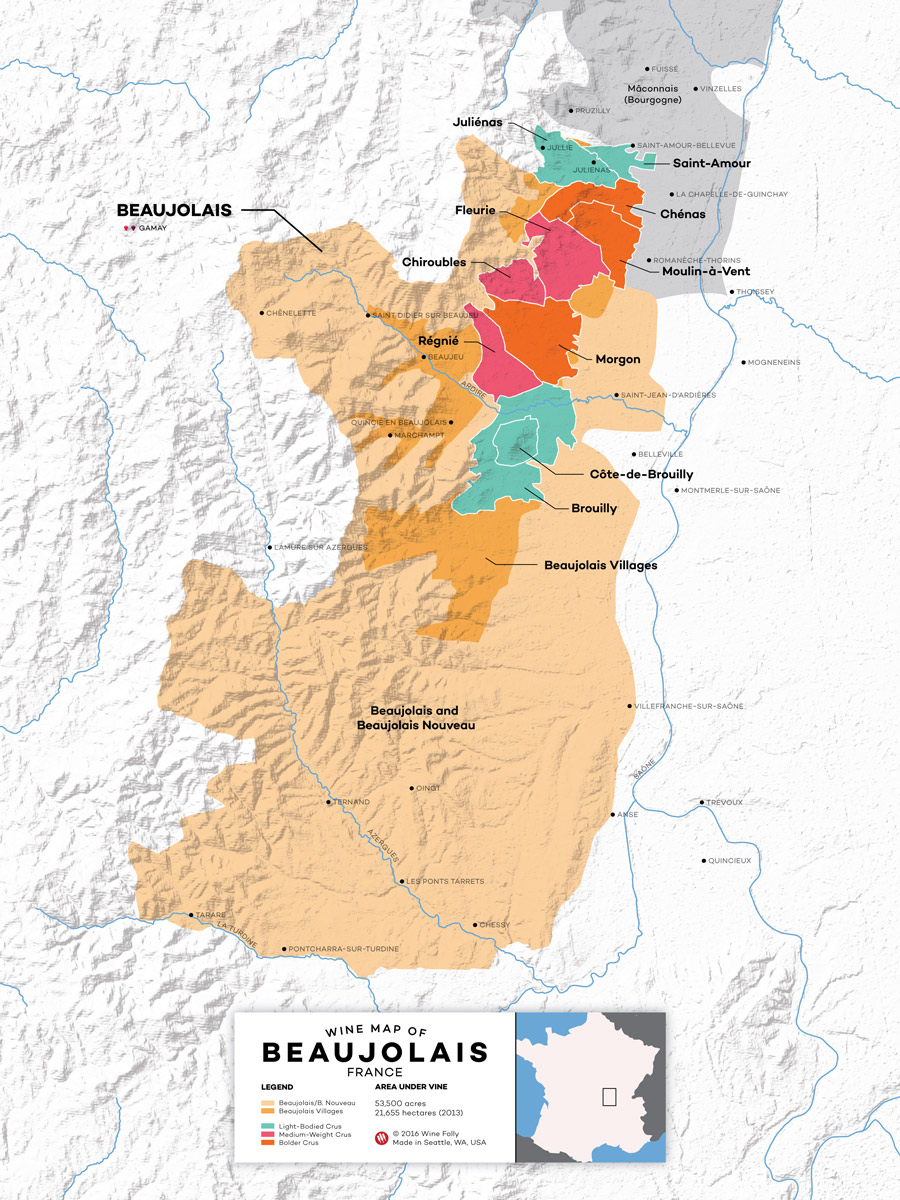What’s the secret to finding good Beaujolais wine? It’s knowing the region – secret revealed!
Beaujolais is the name of a little area in France just south of Burgundy that makes wine with Gamay grapes. It’s one of the few wine regions of France that doesn’t take itself too seriously.

With the help of French wine educator, Hilarie Larson, we’ve created a guide to the Beaujolais region in the hope of shedding some detail on the topic. It’s time to explore the secret and learn how to find good Beaujolais wine.
Find The Best Beaujolais
What is Beaujolais?
Beaujolais is a light red wine made with Gamay Noir grapes.
- Fruit flavors: Raspberry, Tart Cherry, Cranberry
- Other flavors: Mushroom, Forest Floor, Smoke, Violet, Baker’s Yeast, Banana, Bubblegum
- Acidity: High
- Tannin: Low
- Alcohol: 10-13% ABV
- Serving Temp: Slightly chilled at 54-58 °F (12-14 °C)
Learn what basic wine characteristics mean for your taste preferences.
The French wine region of Beaujolais has long been considered part of Burgundy, but today it charts its own course. The more serious crus designations of Beaujolais drink a lot like red Burgundy.
Beaujolais Buying Tips
- Look for the 10 Beaujolais Crus (Morgon, Fleurie, more below!). Expect to spend around $20–$25.
- Great values from Beaujolais Villages or Beaujolais Supérieur on good vintages (2017, 2016, 2015, 2014…) expect to spend around $12 a bottle.

Where is Beaujolais?
- Bordered by Burgundy to the North; the Saône River (which leads to Côtes du Rhône) to the East; the “Gastronomic Capital of France”, Lyon, to the South; and the Monts de Beaujolais (the hills of the Massif Central) on the West.
- Beaujolais is just 34 miles long and 7-9 miles wide.
- Divided into two sections by the Nizerand River, with different soils on each side.
- Beaujolais’ flavor is in the soil. There’s mostly granite and schist (decomposed rock) to the North and clay-based soils (marl) to the South.
- All of the Beaujolais Cru vineyards are located on the Northern side of Beaujolais.

10 Beaujolais Crus
The crème de la crème of Beaujolais!
There are 10 Crus of Beaujolais, all in the north and producing only red wines. Usually, the labels will simply state the name of the Cru.
Each Beaujolais cru has its own distinct personality – climate, soils, altitude, aspect, and a host of other factors – that are duplicated nowhere else. These wines are more complex and are known to age well.
1. Saint-Amour
The perfect Valentine’s Day wine.
The region borders the Mâconnais of Burgundy and there are 12 special “climats” or vineyard plots that can add their name to the label. Check out Les Champs Grillés, En Paradis, Les Bonnets or Le Mas des Tines, to name a few.
Two styles of wine are produced here: a light, fruity, floral wine that shows notes of violet and peach and a bigger, spicier version that becomes more Pinot-like with age.
2. Juliénas
Named after Julius Caesar, these ancient Roman vineyard sites are planted on granite, volcanic and clay soils giving the wines power, structure and terrific aging ability.
Floral and fruity, the aromas of strawberry, peach, violet and spicy cinnamon are common.
3. Chénas
The smallest and rarest of the Crus, the name Chénas refers to the ancient oak forests that once covered the hillsides. Both the Romans and the monks that followed thought that grapes were more important, so they cleared the land. But it was Phillip V who decreed that all the trees be removed and replaced with vines!
Appropriately, the wines often have a ‘woodsy’ quality, but it’s their floral notes of rose and iris, plus silky tannins, that earned them the nickname “bouquet of flowers in a velvet basket.”

4. Moulin-à-Vent
Dubbed “The King of Beaujolais,” this region’s vineyards are grown on decomposed pink granite and soft flaky quartz giving the wines a dark ruby/garnet color, good structure and complexity. These are the most tannic and full-bodied wines of all the Cru. When they’re young you’ll notice lots of plum, cherry and violet notes, but if you can allow the wine to age up to 10 years you’ll be rewarded with more ‘Pinot’ style – dried fruits, earthy truffles, meat and spice.
TIP: Moulin-à-Vent gets its name from a local windmill.
5. Fleurie
This is “The Queen of Beaujolais.” The vineyards are planted at a higher altitude on the steep slopes at the foot of La Madone.
The wines are lighter in style and highly aromatic with a ’feminine’ quality. Think roses, iris and violet along with some ripe red fruits and peach!
If you’re just getting into Bojo, the wines of Fleurie are a great place to start.
6. Chiroubles
This is another Cru for those who adore the lighter style of Beaujolais.
Grown at the highest altitudes of the region (820-1480 feet), this is also the coolest Cru and the last to start harvest each year.
The wines are classic Beaujolais – refined, suave, silky, and elegant. Perfumed aromas of peaches and raspberry mix with Lily of the Valley and baking spices.
TIP: When the vineyards of Chiroubles were originally planted, the granite soil was so hard they had to bore holes in the rock.
7. Morgon
The second largest of the Crus, Morgon is comprised of six climat all with slightly different styles. Their unifying feature is the decomposed schist soil called roches pourries or “rotted rocks” and locals believe this contributes to the ripe cherry aromas found in all the wines.
These are wines meant to age 5–10 years (at least). The young, fleshy palate of peach, apricot, cherry, and plum will develop into a more earthy wine reminiscent of Burgundian Pinot Noir.
8. Régnié
Pronounced “rehn-yay,” it is the newest Cru of Beaujolais.
Wines from these hillside vineyards are terrific when young with tons of aromatic peach, cherry, black currant, and raspberry flavor.
More organic vineyards and winemakers are found in this young, upcoming Cru than all the others!
9. Côte de Brouilly
Known as the “Elegant Wine on the Hill,” here you will find vineyards planted on the volcanic slopes of Mount Brouilly, giving the wines a unique flavor and delicate minerality.
Look for easy drinking wines that have the aromas of fresh grape juice and cranberries, a silky mouthfeel and tons of bright, refreshing acidity.
10. Brouilly
Mount Brouilly is named after Brulius, a famous Roman lieutenant stationed in the area some 2000 years ago.
This is the most southern of all the Cru and just a little bit more Mediterranean with slightly warmer temperatures.
As well as being the largest Cru, it was also one of the original areas allowed to sell its wines to the Parisian market as far back as 1769, making Brouilly one of the most known areas in Beaujolais.
The soil here is unique: a blue/black volcanic rock called Diorite that is known as cornes vertes or “green horns.”
This unique terroir lends an exuberance to the wine’s fruity aromas of jammy plum and strawberry, red currants, and peach. It is meant to be enjoyed young (and often).

There are 3 Classifications of Beaujolais wine:
Beaujolais AOP, Beaujolais Villages AOP and Cru Beaujolais
Beaujolais AOP
This is the biggest appellation consisting of all 96 winemaking villages with most villages located in the south.
Beaujolais AOP are easy to glug because they have refreshing acidity and low tannin. You’ll find the flavors are fruity and even “grapey” – raspberry, cherry, cranberry and, sometimes, a touch of tropical banana (a flavor that comes from the carbonic maceration winemaking method).
The clay soils and flatland terrain in the south of Beaujolais make it more difficult to properly ripen grapes. This is why you’ll find a wide variance of quality in Beaujolais AOP. Still, one style that’s rapidly growing in popularity is rosé.
TIP: Wines labeled “Supérieur” – red or rosé – will be a touch higher in alcohol and most likely darker and more concentrated.
Beaujolais Villages AOP
Moving up the scale we come to the 38 official “Village” wines, 30 of these village names can appear on the label.
These areas are a little more specialized and the wines a little deeper and darker in color and character. Many of these villages are located on granite or schist soils, so they have a more “mineral” character.
Although most of the wines are red with notes of strawberry and black currant, the white wines are also delicious with notes of pear, tropical fruits, and blanched almonds.
SERVE CHILLED: Try serving Beaujolais slightly chilled between 55–60 ºF.
A lil’ History
The Romans were the first to plant vineyards – to keep legionnaires happy! – followed by the Benedictine monks in the Middle Ages.
It was the Dukes of Beaujeu who made the wines fashionable. Originally, the town of Lyon was the main market for Beaujolais wine. In the olden days, goods from outside the area were subject to heavy taxes and this gave the local juice a boost.
When the railroads were built in the 19th century, Beaujolais spread to Paris. This marked the start of the craze for the world’s fastest wine.
Beaujolais Reference
The Technical Stuff
Why Does Beaujolais Taste Like Bananas?
One of the things that sets Beaujolais apart is a particular style of winemaking that is extremely well suited to the Gamay grape.
Most of the wines of Beaujolais are produced through a method known as semi-carbonic maceration that highlights the amazing fruity aromas of the wine.
The grapes are harvested and then, instead of being crushed, the whole clusters are placed in a vat or tank. The pressure of the fruit begins to crush the grapes near the bottom of the vat, expressing their juice. When the juice comes into contact with the indigenous yeast on the grape skins, the juice starts to ferment creating CO2 gas – aka carbon dioxide – which forces the oxygen out of the tank. Often, a lid is placed on the tank to help eliminate the oxygen as well.
This lack of oxygen causes an enzymatic/biochemical form of fermentation to begin inside the grape berry that makes them explode!
After a short maceration period of around 4-8 days, the juice is racked off (the ‘free run”) and the remaining juice is pressed from the skins (the ‘hard press’), then the two are blended together. From this stage the juice will finish fermentation and completed as a ‘regular’ wine.
This style of fermentation is also responsible for the distinctive aromas of banana, candied fruits, pear, raspberry and cranberry in the finished wine!
10 Crus of Beaujolais
- Saint-Amour AOC
- Juliénas AOC
- Chénas AOC
- Moulin-à-Vent AOC
- Fleurie AOC
- Chiroubles AOC
- Morgon AOC
- Régnié AOC
- Côte de Brouilly
- Brouilly AOC
38 Official Beaujolais Villages
- Les Ardillats
- Beaujeu
- Blacé
- Cercié
- Charentay
- Chénas
- Chiroubles
- Denicé
- Emeringes
- Fleurie
- Juliénas
- Jullié
- Lancié
- Lantignié
- Marchampt
- Montmelas-Saint-Sorlin
- Odenas
- Le Perréon
- Pruzilly
- Romanèche-Thorins
- Quincié-en-Beaujolais
- Régnié-Durette
- Rivolet
- St-Amour-Bellevue
- St-Didier-sur-Beaujeu
- St-Etienne-des-Oullières
- St-Etienne-la-Varenne
- St-Symphorien-d’Ancelles
- St-Vérand
- St-Julien*
- St-Lager
- Salles-Arbuissonnas-en-Beaujolais
- Vaux-en-Beaujolais
- Vauxrenard
- Villié-Morgon
- Chânes
- La Chapelle-de-Guinchay
- Leynes
You’ve had a taste of French wine, but there’s so much more to learn:
Getting Started With The Wines of France (Video)
Get confident with the wines of France in this introductory seminar. You’ll learn about the 11 major regions and the best wines to explore.

